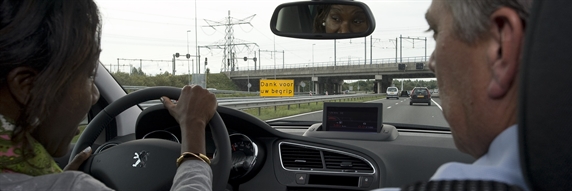Case study Driving together with IJmond Bereikbaar
In the IJmond region, IJmond Bereikbaar (Accessible IJmond) deploys various measures to help companies work on accessibility in a smart and sustainable way. One of these measures is carpooling, or 'driving together'. A digital car-pooling platform links employees who can travel together. This eases the burden on roads and car parks around business locations. More than 700 local participants from a total of seven companies are taking part. Over a period of 12 months, more than 10,000 trips have been made together.
The organisation IJmond Bereikbaar provides the Smart & Sustainable Mobility programme for the IJmond region. The aim of this programme is to work with municipalities and the business community to keep the region accessible in a sustainable way. In this context, the region started 'driving together' in 2018. By driving together to and from work, the capacity of the cars is maximised and the number of almost 'empty' cars decreases. Driving together saves costs, leads to lower CO2 emissions and makes the region easily accessible. The carpoolers in the IJmond region receive a reward for each trip made together.
Implementation
In partnership with the platform Toogethr, IJmond Bereikbaar initially started a pilot project with the 'leaders' of the business community in the region: a few large companies that were already members of IJmond Bereikbaar's employer network. The pilot project proved to be a success and was subsequently extended. Seven companies in the region are now participating in driving together.
Toogethr approaches employees to take part in driving together through their employers. Employees can download the Toogethr app and then sign up by filling in their home address, work location, working days and working hours. The app then shows which participants in the community are eligible for driving together. The employee can invite someone for a trip and exchange contact information, after which driving together can begin. GPS tracking makes it possible to see if people have actually driven together and minimises the risk of fraud.
In order to make participation attractive to employers, IJmond Bereikbaar covers the cost of driving together for the first year. If, after this year, driving together turns out to be successful, the companies will pay a part. There are one-off implementation costs and also a licensing model, in which companies pay €1 to €2 per month per participant. Finally, a budget is needed for communication and activating the participants, and of course for rewarding them. The IJmond region gives a reward of €1 per co-driver per day.

Results
In the pilot phase, a target of 250 rush-hour avoidances per week was set for the first six months. IJmond Bereikbaar was responsible for bringing in companies; Toogethr for a sufficient number of participants. This goal was easily achieved: in the first few months, there were more than 500 rush-hour avoidances per week. More than 700 employees in the IJmond Bereikbaar region have now downloaded the Toogethr app. These participants have made a total of more than 10,000 trips together, saving more than 62,000 kg of CO2.
In addition to these numerical results, Toogethr monitors the satisfaction of the participants through surveys and interviews. These show that the experiences of driving together are good. Co-drivers like to gain insight into which colleagues actually live in their neighbourhood and have a similar profile in terms of commuting. In addition, co-drivers also much appreciated the ease of inviting and making appointments with colleagues.
Considerations for deployment elsewhere
The following considerations apply to the use of carpooling:
- Determine the accessibility problem in the region and respond to this. A poorly accessible region with full parking spaces is more promising for carpooling than a region where you can easily drive to work every day and park your car in front of the door.
- Driving together is generally better suited to employees with a fixed workplace, fixed working hours, and with commuting distances of more than 25 kilometres one way.
- Use an existing network and start with a leader group. This enables you to create support among other companies.
- Emphasise that this relieves employees of a burden. They need only provide email extensions and make a budget available for rewards and communication/activation.
- Emphasise the benefits for the employer: for example, less crowding in the car park, and therefore more room for visitors. Furthermore, carpooling contributes to sustainability plans (such as an environmental plan).
- Be sure to reward employees for driving together. This need only be a small amount of money, but is an important trigger for participation. Be aware of the tax consequences that giving a reward may entail.
- In order to make carpooling attractive to employees, it is important to maintain the travel allowance. So the reward for travelling together comes on top of that. In the case of Toogethr and IJmond Bereikbaar, driving together is organised outside the employer's own organisation and there is no question of 'transport provided by the employer'. The employer is therefore still entitled to reimburse the untaxed travel expenses.

